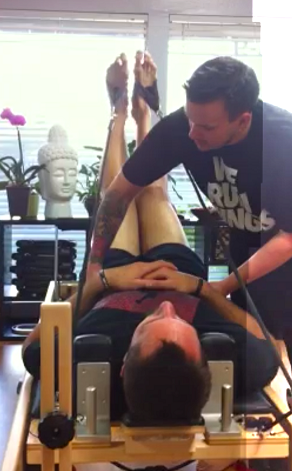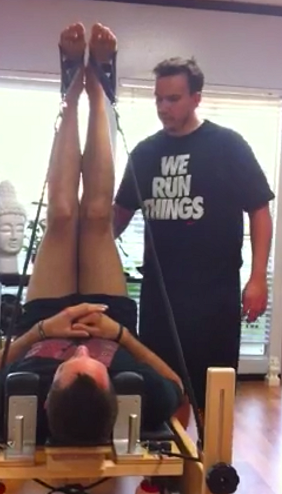One of the first remarkable quotes I remember hearing from my first Pilates Instructor was, “Pilates is about what to let go of more than what to contract.” Not only is that just a golden rule by which to govern life, but it’s a phrase that enters my thoughts often when I train any body and specifically athletes. When people hear that I work with athletes they mostly assume I’m privileged to work with superior movers that Teaser and Snake all session every session. That ain’t the truth. Mostly my work with this population (and more over my work in general) is about fluidity, exploration, and creating a sense of ease in movement. The work almost always harkens back to that first mantra – Let go.
I’m sort of in a lucky spot both geographically and socially. My studio, Evolved Body, is located just outside of Sacramento, CA, an area that produces more NCAA athletes than any other region in the US. We’re a city of recreational and league sports, outdoor activities, and many pro-athletes call the area home. Additionally some of my best friends are coaches and sports agents. I was even coaxed into my first Pilates training (from teaching Yoga) by a friend who paid for that workshop in return for me training some of the athletes he was coaching. I guess it could be said that I just stumbled into working with athletes, but had the tenacity and confidence to learn how to make myself really quite good at teaching them.
 And I believe what makes a good teacher has less to do with what he knows and more to do with how much he listens to his clients. What I was hearing again and again from athletes was routinely something along the lines of Why hasn’t anyone ever told me _________!?!?? That blank could be filled with questions of how to move through their foot, mobilize a hip, or some reciprocal relationship within the body. That blank was often something that seemed logical and fundamental to me, and yet trainers and coaches had never emphasized or much less mentioned said blank. What I know to be true is that people benefit when they let go of “performing” an exercise and start to “experience” the movement. Athletes come to work with me and are specifically good at their sport, but not always generically good at movement. They’ve been coached and have practiced for hours how to shoot, pitch, kick to score, and pedal, but seldom how to reach, twist, squat and never about how to lengthen, organize, or integrate. Often they are dynamically developed in specific muscles and movement patterns, and ineffectively weak in others, regularly causing discomfort and injuries.
And I believe what makes a good teacher has less to do with what he knows and more to do with how much he listens to his clients. What I was hearing again and again from athletes was routinely something along the lines of Why hasn’t anyone ever told me _________!?!?? That blank could be filled with questions of how to move through their foot, mobilize a hip, or some reciprocal relationship within the body. That blank was often something that seemed logical and fundamental to me, and yet trainers and coaches had never emphasized or much less mentioned said blank. What I know to be true is that people benefit when they let go of “performing” an exercise and start to “experience” the movement. Athletes come to work with me and are specifically good at their sport, but not always generically good at movement. They’ve been coached and have practiced for hours how to shoot, pitch, kick to score, and pedal, but seldom how to reach, twist, squat and never about how to lengthen, organize, or integrate. Often they are dynamically developed in specific muscles and movement patterns, and ineffectively weak in others, regularly causing discomfort and injuries.
Movement Educator, Gray Cook, has one of my favorite quotes, “The language of movement is written in feel.”
Too few athletes, especially young athletes, have been given quality sensory experiences that help their body strategize and organize foundational movement patterns. If they can score a threepointer that’s enough for a coach. How they land is beyond question. Basketball happens to be one of my favorite sports. If you’re not faint of heart (and have a strong stomach), search for Paul George in the 2014 Team USA scrimmage, or Kevin Ware in the 2013 NCAA Tournament. Literally these guys jumped and landed, and what happened next was awful. Certainly nutrition, prior injuries, and physics could have played vital roles in their injuries, but any movement instructor who looks at those videos will notice just plain bad movement mechanics. They had no sense of their feet, or their abdominal complex, and certainly didn’t have an integrated relationship with gravity. They didn’t have sound movement strategies, and probably had never been exposed to how good movement can feel. How many of your clients do you watch robotically going through footwork (and to the point probably poorly)? Now imagine that coupled with years of organizational training in very specific rigid sport-performance movement patterns.
 From my perspective that is the genius of the Pilates Method. Yes, there are some amazing exercises that strengthen and stretch, but if you think of the apparatus as more of an experience and less of a machine, well that’s a whole new world. It doesn’t matter if you’re Classical or Contemporary, those exercises are just points on a movement map and the real beauty (and experience) is what’s going on within the person
From my perspective that is the genius of the Pilates Method. Yes, there are some amazing exercises that strengthen and stretch, but if you think of the apparatus as more of an experience and less of a machine, well that’s a whole new world. It doesn’t matter if you’re Classical or Contemporary, those exercises are just points on a movement map and the real beauty (and experience) is what’s going on within the person
as they travel through those movements. That’s a vista often missed when we’re austerely performing an exercise. I find the more I can help my athletes to embody and explore what they’re doing, be it by dialoguing, breath work, or slowing/speeding up a movement, the more challenging it is for them and the more they feel it was a “worthwhile” hour spent practicing healthy movement (what we call Pilates). Their time with me has to feel immediately beneficial, and it’s doubtful that I’ll teach them more about their sport than their coach, or be a more sweat-inducing workout than their sport-performance clinics, but I can assuredly teach them how to better occupy their space and have fun doing it.
As a Pilates Instructor I realize all I have to sell is my time. So my time better be pretty “worth it” to entice people who already move a lot. Exploring the whole body as a movement system seems to be pretty worth it. What I have found constructive is to help this population traverse subtle relationships within the body. Those subtle relationships (scapular rhythms / foot articulations / pelvic floor integration) look to be the most in need. Subtle doesn’t appear important when there’s a real danger of being run over by a guy twice your size, but it’s an easy sell
when you can explain how a well-organized muscular-fascialneural network will help them excel in their sport. From there it’s simple, you work as you would with any other client: you see the body and help them to strengthen the body.
 James Crader is a Movement Practitioner specializing in Pilates and John F. Barnes Myofascial Release Therapy, a CoreAlign Faculty Member, and owner of Evolved Body in Sacramento, CA. His work with athletes was recently featured in Mark Pedri’s Pilates documentary A Movement of Movement. Originally trained through Balanced Body, James has since gone on to study with numerous instructors both Contemporary and Classical including a mentorship program with Pilates Elder, Lolita San Miguel. James feels privileged to have been asked to teach workshops nationally, and internationally in Joseph Pilates hometown of Monchengladbach. His passion is to assist people in exploring how their bodies can move and feel better, from a re-conditioning environment to athletic performance training.
James Crader is a Movement Practitioner specializing in Pilates and John F. Barnes Myofascial Release Therapy, a CoreAlign Faculty Member, and owner of Evolved Body in Sacramento, CA. His work with athletes was recently featured in Mark Pedri’s Pilates documentary A Movement of Movement. Originally trained through Balanced Body, James has since gone on to study with numerous instructors both Contemporary and Classical including a mentorship program with Pilates Elder, Lolita San Miguel. James feels privileged to have been asked to teach workshops nationally, and internationally in Joseph Pilates hometown of Monchengladbach. His passion is to assist people in exploring how their bodies can move and feel better, from a re-conditioning environment to athletic performance training.
